Heho und so, Freunde des lustigen Pedalierens.
Meine Finger sind noch immer vom Karpaltunnelsyndrom taub, deshalb habe ich diesmal eine gute Ausrede für Tipp- und Rechtschreibfehler. Aber ich möchte euch trotzdem gern mitnehmen in das marokkanische Atlasgebirge und den Sand drumherum. Also schiebt den Seidenvorhang zur Seite, setzt euch an den Brunnen mit seinem wunderschönen Mosaikmuster, gönnt euch einen Tee, riecht die Gewürze und hört meine Kunde von Dromedaren im Straßenverkehr, Wüste soweit das Auge reicht und hört die Klänge von orientalischer Musik.
Habt ihr es? Soooo…Pustekuchen erstmal.

Es regnet in Strömen! Einen der zehn Regentage in Marokko haben wir erwischt. Pünktlich zum alljährlichen Atlas Mountain Race. Ein Rennen, 1350 km und 24000 hm offroad, bestenfalls mit einem Mountainbike, das mindestens vorn gefedert ist, durch, über und im Atlas- und Antiatlas Gebirge und durch die Wüste Marokkos, beginnend in Marrakesch bis zum Ziel an der Atlantikküste in Essaouira.

Der Bikecheck ging fix. Ich habe alles. Der Tracker läuft, die Bremsen bremsen, die Lichter leuchten. Nur Dennis, mein Mitbewohner im Hotel, grunzt neben mir. Für ihn ist es ganz gut, dass es heute am Freitag noch nicht losgeht. Er hat eine Magenverstimmung. Da hat ihm das komplett durchgebratene Steak vom Vorabend nicht gut getan. Beim Briefing, knapp 2 Stunden vor Start, wird uns gesagt, dass die Behörden den Startschuss um 24 Stunden verschoben haben. Zu gefährlich ist es, dass knapp 320 Radfahrer bei vorausgesagten 35 Litern/m² in den Abend zum Atlas starten. Schnee, überlaufende Flüsse und Erdrutsche sind vorprogrammiert. Also einen Tag warten. Aber das passt schon.
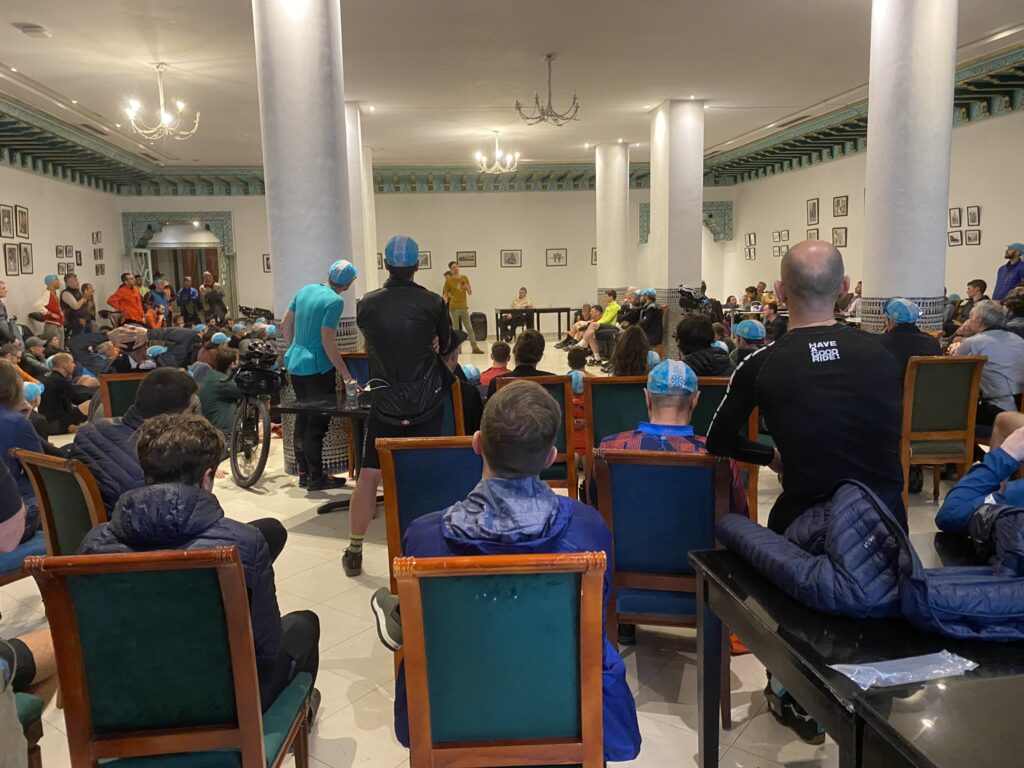
Meine kleine Rosel, die “endgeile Ghettobitch“, hat also noch einen Tag Ruhe. Dabei bekomme ich für sie teils Applaus, teils Häme. Die einen sagen, es wäre ein Oldschool Statement und die anderen, sie wäre nur ein Kinderfahrrad mit ihren 26-Zoll-Reifen. Ich wollte mir eben nicht extra ein neues Bike nur für dieses Event kaufen. Mit Rosel bin ich schon vor 7 Jahren durch die Alpen geballert. Also, was soll schon schiefgehen?
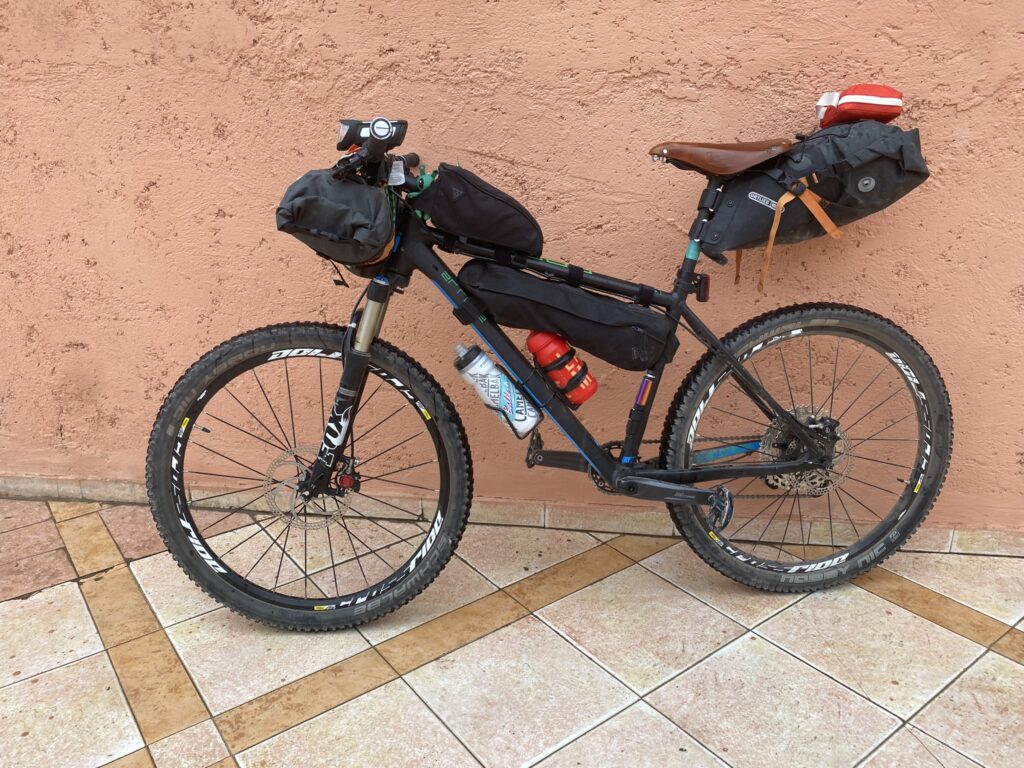
Am nächsten Tag geht es Dennis wieder besser und er und sein extra aufgebautes Kocmo-Bike stehen aufgeregt am Start. Etwa 30 Minuten vor “Go” haben wir eine Nachricht bekommen, dass es draußen auf der Straße ein wichtiges Briefing gibt. Das ist meiner Meinung nach der zweite kommunikative Fauxpas. Denn es wird uns da auch gleich noch eröffnet, dass jetzt jeder auf eigene Verantwortung fährt, da die marokkanischen Behörden das Rennen nicht offiziell freigegeben haben. Nelson gibt jetzt quasi den Startschuss auf eigene Faust. Aber dazu später etwas mehr.
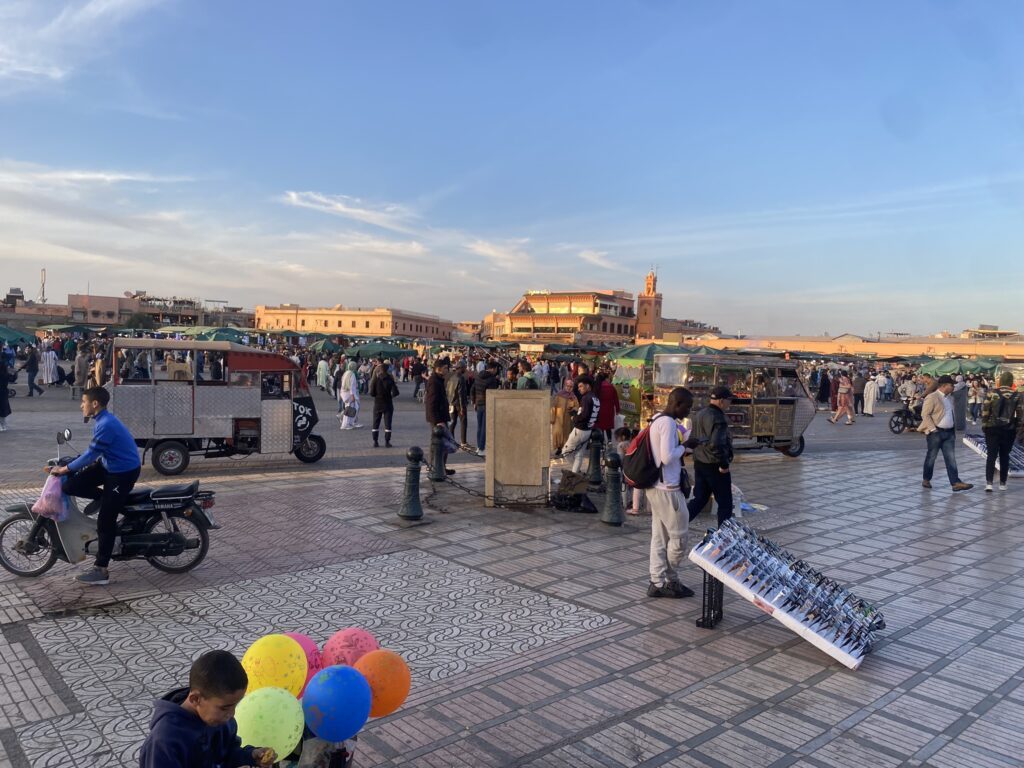
Bei mir greift jedenfalls auch der Gruppenzwang und ab dem Start trennen sich die Wege von Dennis und mir fürs Erste. Dennis ist nach eigener Aussage nicht hierher gekommen, um Letzter zu werden, sondern das Ding zu gewinnen. Den Zahn hab ich ihm schon im Hotelzimmer ziehen wollen und gemeint, dass hier vorn ganz andere Kräfte wirken und er froh sein kann, wenn er unter die Top 50 fährt. Für mich ist Ankommen das Ziel. Immer vor der Schnecke will ich sein, die auf der Trackingmap im Internet mit durchgehend 10 km/h ihre Bahn zieht. Sie ist der sogenannte Besenwagen bis zum Zeitlimit im Ziel. Die letzten Tage haben wir uns in Marrakesch und Umgebung etwas umgesehen und die heimische Folklore an den touristischen Hotspots mehr oder weniger genossen.
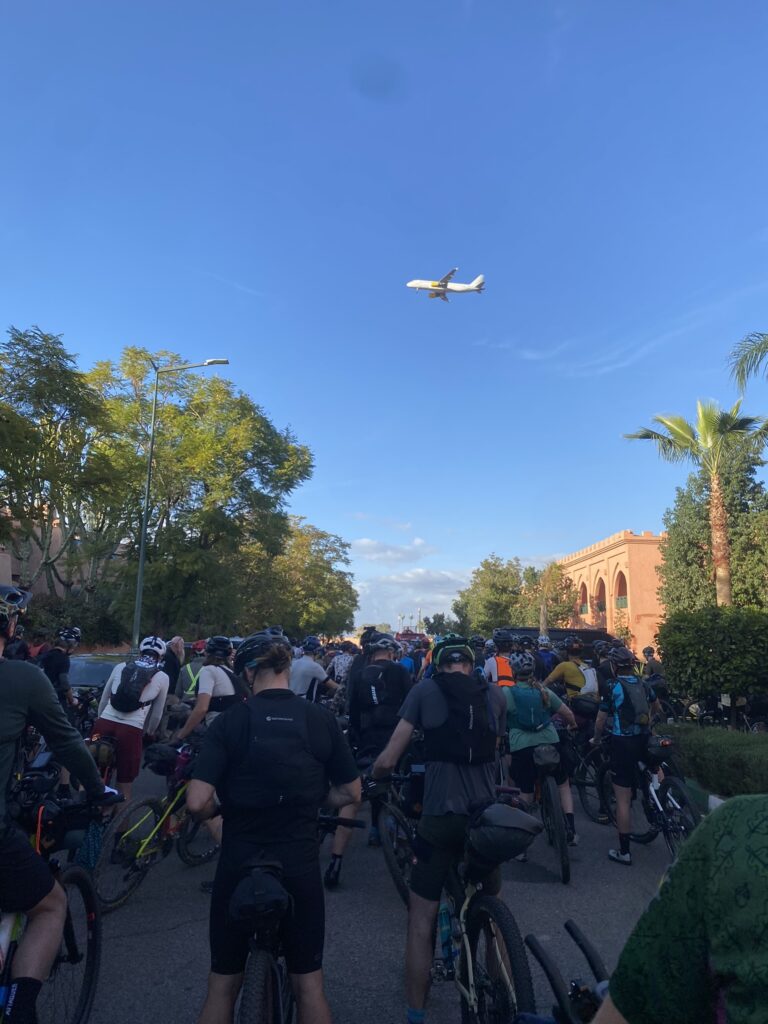
Kurz bevor sich alle in Bewegung setzen, fliegt noch ein Flugzeug über uns herein und wir starten alle mit einer guten Stimmung in den Sonnenuntergang. Erstmal geht es gemeinsam durch den äußeren Stadtverkehr von Marrakesch in Richtung Atlasgebirge. Die ersten 40 Kilometer in Gruppen, dann zerteilt sich das Feld auch schon immer mehr. Durch den Regentag wurde die Route komplett geändert und keiner hat so eine richtige Ahnung wo es lang geht. Teilweise ist es auch wirklich chaotisch, aber überall stehen Polizei, Gendarmerie und sogar eine Ambulanz fahren die ganze Nacht hoch und runter und zeigen uns den Weg, der komplett über Asphaltstraßen geleitet wird. Ich hänge mich einfach an einen anderen Fahrer dran, auch wenn uns einige andere entgegenkommen. Irgendwann dreht er sich um und fragt, ob ich den Weg kenne. Ich antworte nur, dass ich sein rotes Rücklicht gesehen habe und ihm einfach folge. Überall sind auf den Straßen Steine und Schlamm heruntergekommen und ich kann mir vorstellen, wie es auf der ursprünglichen Route über Stock und Stein aussehen muss. Nicht auszudenken, wir wären alle gestern im Regen gestartet, so wie Nelson, der Veranstalter, das ursprünglich wollte. Das wäre unverantwortlich gewesen. Unter uns, das war der erste Fauxpas.
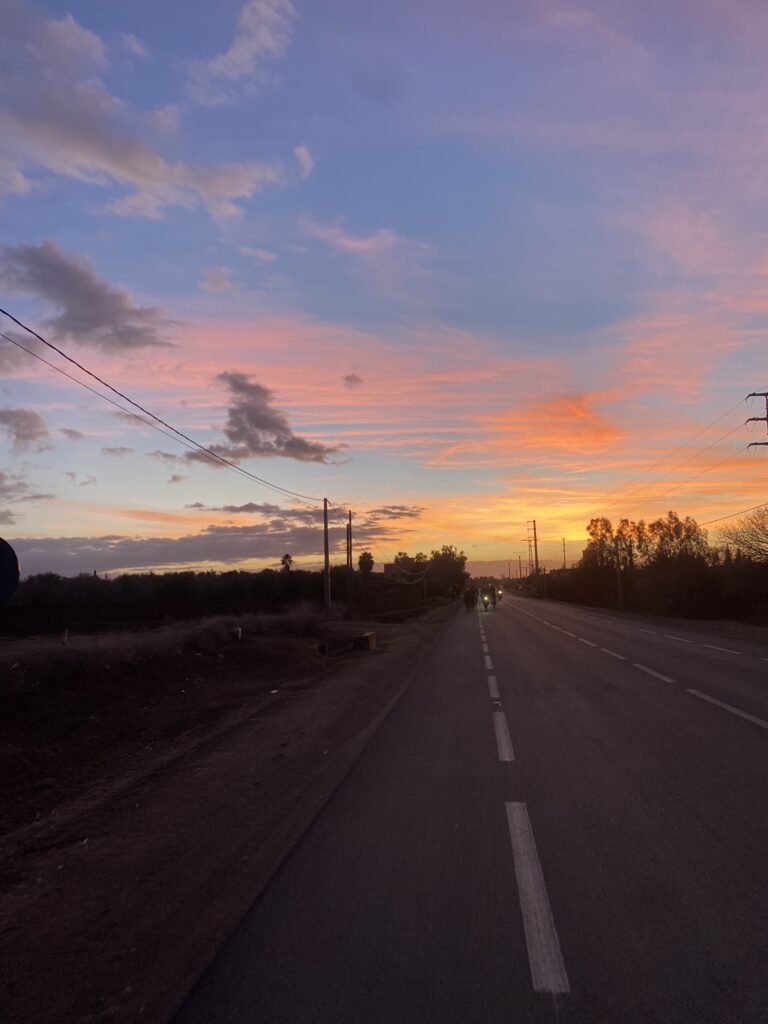
Auf jeden Fall geht es in die Nacht und ich habe nach 80 Kilometern wirklich die Schnauze voll. Was mache ich denn überhaupt hier? Ich bin völlig unfit und habe keine Kraft in den Beinen. Aber der erste Scratcher will ich auch nicht sein. Also kurz ein Snickers rein, ein paar wärmere Klamotten an und weiter den Berg hoch. Irgendwann kommt am Anfang des Tizi n’Tichka Pass eine Raststation in Zerkten. Hier halten wohl auch viele Busse und Autos, weil es ein Verbindungsstück ist und die nächsten Städte etwas weiter weg sind. Also gibt es hier für mich, neben vielen anderen Fahrern, eine Suppe, etwas Brot und frisch gebrühten Pfefferminztee. Jetzt geht es weiter nach oben auf 2260 hm, das Dach der ganzen Route und als ich endlich nach unten fahren kann, kommt Wind auf. Viiiieeeeel Wind. Vorn von der Seite. Teilweise pustet es mich fast vom Rad. Ich habe auch von einigen gehört, dass sie bergab schieben mussten und auch von wenigen, die dadurch auf der Abfahrt gestürzt sind und dadurch aufgeben mussten. Ich und ein paar andere, nehmen gut eine Stunde die Windkante in Kauf und fahren vorsichtig, teils schräg gegen den Wind, bis wir nach gut 11 Stunden am Checkpoint Eins ankommen. Dort gibt es den ersten von vier Stempeln, eine Tajine (ein Schmortopf, in dem meist Gemüse gegart wird), Cola, Tee und einen Kaffee. Um mich herum liegen alle im Bettenlager auf Matratzen, Bänken und dem Boden. Ich will aber weiter. Rein in den Sonnenaufgang und den Wind im Rücken. Dabei kommt mir das Windparadox dazwischen. Denn wenn man einmal Rückenwind haben könnte, ist dieser auf einmal hinter der nächsten Anhöhe verschwunden.
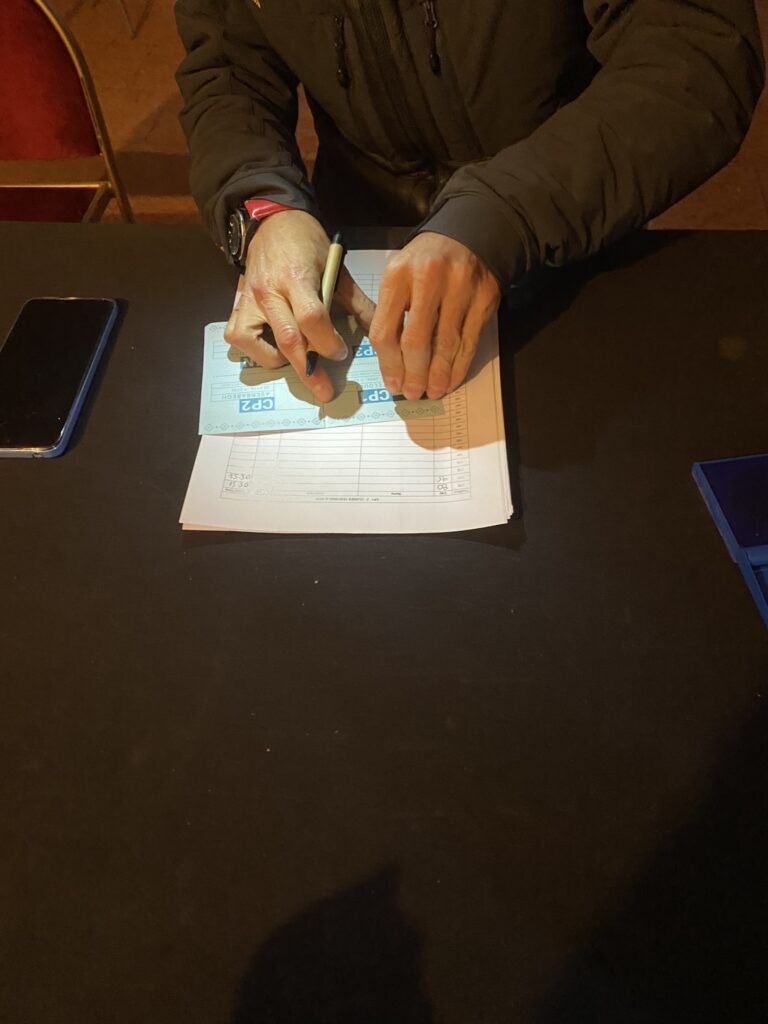
Am heller werdenden Tag geht es jetzt dem ersten wirklich steilen Offroad-Abschnitt entgegen. Oben blinken überall Lichter. Überall dicke Steine und auch noch Schlamm. Von oben sieht man, dass ich unten durch ein trockenes Flussbett gefahren bin. Beim Briefing haben sie uns gewarnt, dort zu schlafen. Durch den Regen werden sie in Minuten zu reißenden Flüssen. Aber das Wasser geht auch so schnell, wie es gekommen ist.
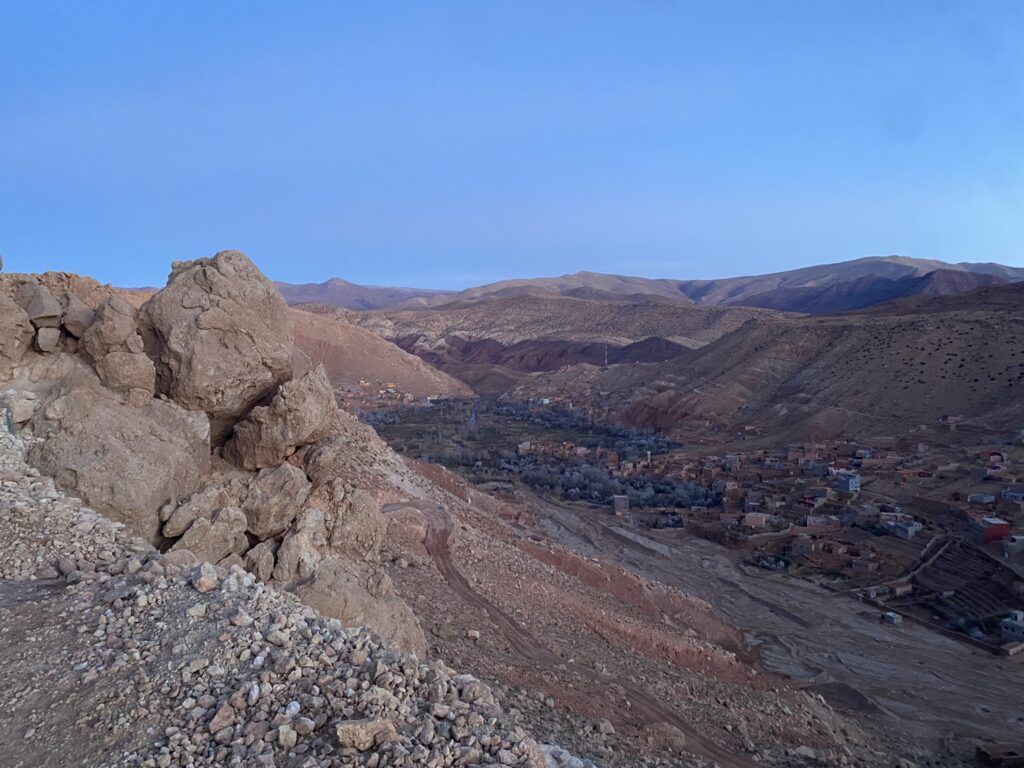
Es geht über den Atlas immer auf einem Hochplateau entlang. Der erste wirkliche Kick für mich. Die Aussicht ist fantastisch. Angesichts der Natur und der Stille fühlt man sich als Mensch absolut klein. Es ist ein wahnsinnig tolles Gefühl der Demut und Dankbarkeit, die mich hier ergreift, dass ich in der privilegierten Situation bin, dieses Hobby ausüben zu dürfen.
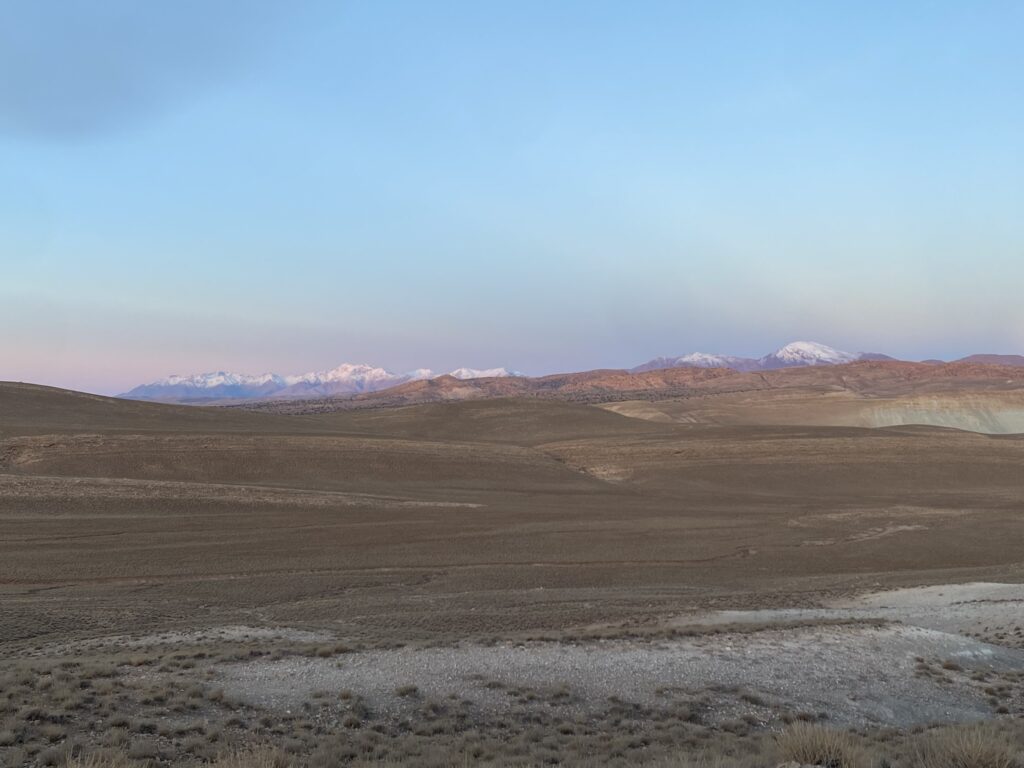
Hier gibt es jetzt keine Straße mehr, nur Wanderwege und die Sonne fängt auch langsam an zu brennen. Ab 11 Uhr wird es wirklich heiß und durch Flüsse und Felsen geht es durch teilweise sehr kleine Dörfer, in denen kaum jemand zu wohnen scheint. Außerdem geht es immer langsamer voran. Wo ich anfangs noch eine Durchschnittsgeschwindigkeit von 16 km/h hatte, schrumpft diese immer mehr in sich zusammen.

Irgendwie komme ich am Nachmittag wieder auf eine schnellere Asphaltstraße und verpasse im Rausch der Gefühle den Resupply Point. Also heißt es im wieder aufgefrischten Gegenwind, der über die Berge weht, die Wasservorräte gut einteilen. 30 Kilometer habe ich noch und das wird wirklich ein weiter Weg. Zwischenzeitlich fahre ich durch einen Canyon und dort auch über eine Dorne, die hier überall auf den Wegen wachsen oder liegen und mir den Reifen durchsticht. Erster Platten nach 250 Kilometern. Schnell erledigt, den Schlauch gewechselt und jetzt Daumen drücken, dass das der erste und auch letzte Platten war. Einen Schlauch und viel Flickzeug habe ich aber noch in Reserve mit. Denn Radläden habe ich bis hierhin noch keinen einzigen gesehen. Beim Schließen meiner Rahmentasche reißt mir der Reißverschluss obendrein auch noch. Also darf ich die restlichen knapp 1100 Kilometer durch die Wüste mit offener Tasche fahren, die ich nur notdürftig mit Kabelbindern zusammen halte. Spoiler, es hält bis zum Schluss.
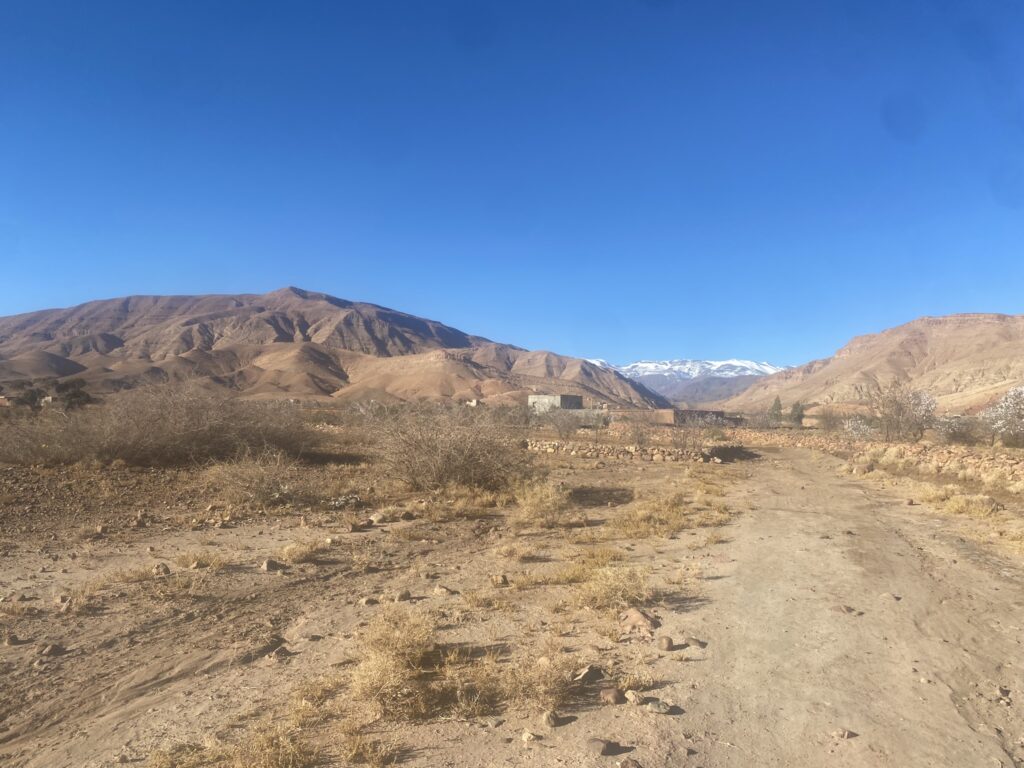
Es kommt dann glücklicherweise ein Miniladen und ich kann Wasser und etwas Limo, die ich immer in meinen vorderen Flaschen habe, auffüllen.
Über steinige Abschnitte geht es wieder weiter hoch und runter und die Route macht mich nun auch das erste Mal richtig fertig. Vielleicht ist es jetzt auch meine aufkommende Müdigkeit. Es gibt hier keinen Weg und immer wieder werde ich in kleine Täler geführt, wo ich das Rad nach unten tragen muss, da es zu steil ist, dann unten 50 m zu schieben und dann wieder nach oben zu klettern. In diesen kleinen Tälern gibt es in den Hang gegraben einzelne Höhlen, in denen Menschen wohnen. Auch Kleinkinder sind zu hören. Mitten in der Wildnis ohne fließend Wasser und Strom. Krass für mich als Mitteleuropäer. Aber zur Einschätzung der Lebensqualität komme ich in den späteren Kapiteln.

Um ca. 21 Uhr komme ich dann an einem Highwayrestaurant an und stoppe, um ein Omelett, einen Tee und eine Cola zu trinken. Dieses Omelett und das Sitzen macht mich dann so müde, dass ich mich doch entschließe, jetzt hier meinen ersten Schlaf einzulegen. Der nächste Abschnitt ist mit 96 Kilometern ohne Resupply durchs Gebirge ausgeschrieben und nach 32 h auf dem Rad ohne Schlaf, mit 300 Kilometern und 5500 Höhenmetern, reichen für den ersten Hieb. Drinnen darf ich nicht in der Ecke schlafen, also lege ich meine Isomatte und den Schlafsack einfach hinters Haus und schlafe schnell ein.
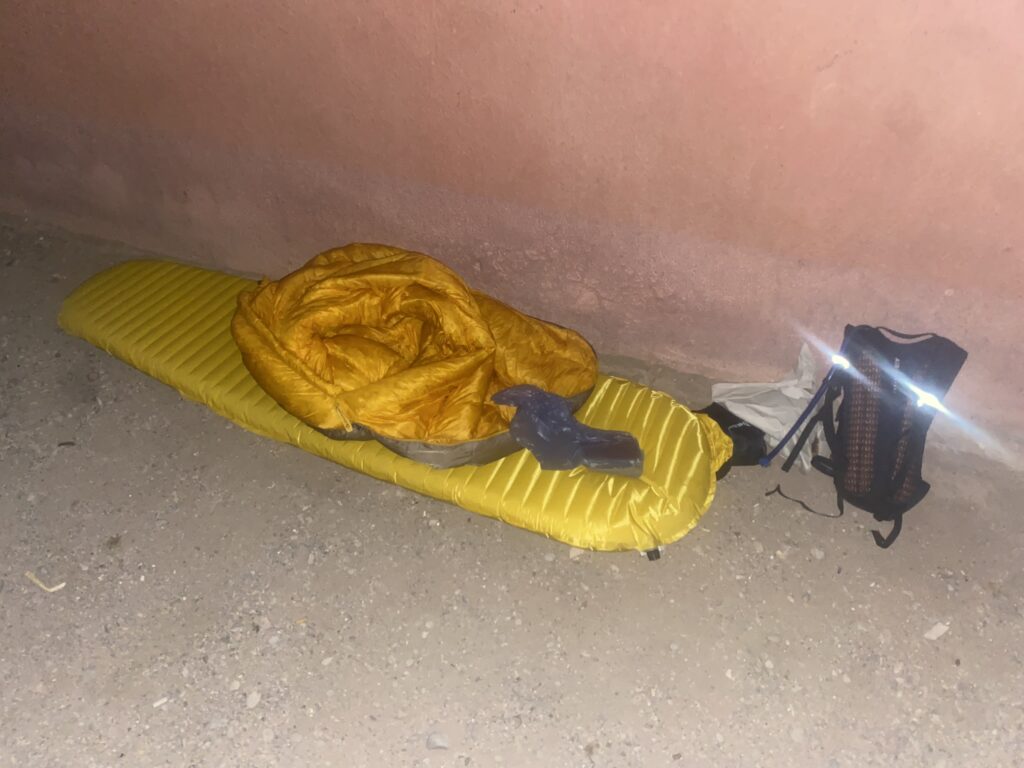
Atlas Mountain Race Part 1 or „From the rain into the desert“
Heho and all, friends of fun pedaling.
My fingers are still numb from carpal tunnel syndrome, so this time I have a good excuse for typos and spelling mistakes. But I’d still like to take you to the Moroccan Atlas Mountains and the sand around them. So push aside the silk curtain, sit by the fountain with its beautiful mosaic pattern, treat yourself to a cup of tea, smell the spices and listen to my story of dromedaries on the road, desert as far as the eye can see and the sounds of oriental music.
Got it? Soooo… fiddlesticks for now.
It’s raining cats and dogs! We caught one of the ten rainy days in Morocco. Just in time for the annual Atlas Mountain Race. A race, 1350 km and 24,000 m off-road, at best with a mountain bike that has at least front suspension, through, over and across the Atlas and Anti-Atlas mountains and through the Moroccan desert, starting in Marrakesh and finishing on the Atlantic coast in Essaouira.
The bike check went quickly. I have everything. The tracker is running, the brakes are working, the lights are on. Only Dennis, my roommate at the hotel, grunts next to me. It’s a good thing for him that we’re not starting today, Friday. He has an upset stomach. The fully cooked steak from the previous evening didn’t do him any good. At the briefing, just 2 hours before the start, we are told that the authorities have postponed the start by 24 hours. It is too dangerous for almost 320 cyclists to set off for the Atlas in the evening with 35 liters/m² predicted. Snow, overflowing rivers and landslides are inevitable. So wait a day. But that’s fine.
So my little Rosel, the „endgeile Ghettobitch“, has one more day of rest. I receive both applause and malice for her. Some say it’s an old-school statement and others say it’s just a children’s bike with its 26-inch tires. I didn’t want to buy a new bike just for this event. I already rode Rosel through the Alps 7 years ago. So what could possibly go wrong?
The next day Dennis is feeling better again and he and his specially assembled Kocmo bike are excitedly waiting at the start. About 30 minutes before „Go“ we got a message that there was an important briefing outside on the road. In my opinion, this is the second communication faux pas. We were also told that everyone was now riding at their own risk, as the Moroccan authorities had not officially approved the race. Nelson now gives the starting signal on his own, so to speak. But more on that later.
In any case, I am also subject to peer pressure and from the start Dennis and I part ways for the time being. According to Dennis himself, he didn’t come here to finish last, but to win the thing. I had already tried to get the better of him in the hotel room and said that there were completely different forces at work here and that he would be lucky if he finished in the top 50. For me, arriving is the goal. I always want to be ahead of the snail on the tracking map on the internet, which is running at 10 km/h all the way. It is the so-called broom wagon until the time limit at the finish. We’ve spent the last few days looking around Marrakech and the surrounding area and more or less enjoying the local folklore at the tourist hotspots.
Just before we all set off, an airplane flies overhead and we all set off into the sunset in a good mood. First we ride together through the outer city traffic of Marrakech towards the Atlas Mountains. The first 40 kilometers in groups, then the field splits up more and more. Due to the rainy day, the route was completely changed and nobody had any real idea where to go. Sometimes it’s really chaotic, but there are police, gendarmerie and even an ambulance driving up and down all night to show us the way, which is completely on asphalt roads. I simply follow another driver, even though there are a few others coming towards us. At some point he turns around and asks if I know the way. I just reply that I’ve seen his red tail light and just follow him. There are stones and mud all over the roads and I can imagine what it must be like on the original route over hill and dale. I can’t imagine if we had all started yesterday in the rain, as Nelson, the organizer, had originally wanted. That would have been irresponsible. Between us, this was the first faux pas.
In any case, it’s off into the night and after 80 kilometers I’m really fed up. What am I even doing here? I’m completely unfit and have no strength in my legs. But I don’t want to be the first scratcher either. So I have a quick Snickers, put on some warmer clothes and carry on up the mountain. At some point, at the start of the Tizi n’Tichka Pass, there is a rest stop in Zerkten. Many buses and cars stop here because it is a connecting road and the next towns are a little further away. So I, along with many other drivers, have soup, some bread and freshly brewed peppermint tea. Now it’s on up to 2260 m, the roof of the whole route, and when I can finally ride down, the wind picks up. Lots and lots of wind. From the side in front. At times it almost blows me off my bike. I also heard from some people that they had to push downhill and also from a few who crashed on the descent and had to give up as a result. Me and a few others take the wind edge for a good hour and ride carefully, sometimes diagonally against the wind, until we arrive at Checkpoint One after a good 11 hours. There we get the first of four stamps, a tajine (a casserole in which vegetables are usually cooked), Coke, tea and a coffee. Everyone around me is lying on mattresses, benches and the floor. But I want to keep going. Into the sunrise with the wind at my back. But the wind paradox gets in the way. Because once you might have a tailwind, it suddenly disappears behind the next hill.
As the day gets brighter, I head towards the first really steep off-road section. Lights are flashing everywhere at the top. Thick stones and mud everywhere. From the top you can see that I’ve driven through a dry riverbed at the bottom. At the briefing, they warned us not to sleep there. The rain turns them into raging rivers in minutes. But the water goes as quickly as it comes.
We continue across the Atlas along a high plateau. The first real thrill for me. The view is fantastic. In the face of nature and the silence, you feel absolutely small as a human being. It’s an incredibly great feeling of humility and gratitude that takes hold of me here, that I am in the privileged situation of being able to pursue this hobby.
There are no more roads here, just hiking trails, and the sun is slowly starting to burn. From 11 a.m. onwards, it gets really hot and I pass through rivers and rocks, sometimes through very small villages where hardly anyone seems to live. I also make slower and slower progress. Where I had an average speed of 16 km/h at the beginning, this is shrinking more and more.
Somehow I get back onto a faster asphalt road in the afternoon and miss the resupply point in a frenzy of emotions. So, with the headwind picking up again and blowing over the mountains, I have to make sure I have enough water. I still have 30 kilometers to go and it really is going to be a long way. In the meantime, I ride through a canyon and over a thorn, which grows or lies everywhere on the paths here and punctures my tire. First flat tire after 250 kilometers. Quickly done, changed the tube and now fingers crossed that this was the first and last puncture. I still have an inner tube and plenty of repair kit in reserve. Because I haven’t seen a single bike store so far. When I close my frame bag, the zipper also tears. So I have to ride the remaining 1100 kilometers through the desert with an open bag, which I only hold together with makeshift cable ties. Spoiler, it holds until the end.
Fortunately, there is a mini store and I can fill up with water and some soda, which I always have in my front bottles.
The route continues up and down over rocky sections and this is the first time I’ve been really worn out. Maybe it’s also my growing tiredness. There is no path here and again and again I am led into small valleys where I have to carry the bike down because it is too steep to push it 50 m down and then climb back up again. In these small valleys, there are individual caves dug into the hillside where people live. Even small children can be heard. In the middle of the wilderness without running water or electricity. It’s amazing for me as a Central European. But I’ll come to an assessment of the quality of life in later chapters.
At around 9 pm, I arrive at a highway restaurant and stop for an omelette, a cup of tea and a Coke. This omelette and the sitting makes me so tired that I decide to have my first sleep here. The next section is advertised as 96 kilometers without resupply through the mountains and after 32 hours on the bike without sleep, with 300 kilometers and 5500 meters of altitude, that’s enough for the first blow. I’m not allowed to sleep in the corner inside, so I simply put my sleeping mat and sleeping bag behind the house and quickly fall asleep.
Um das Ding zu gewinnen! Was denn sonst! Neee albern 🙂
Klasse … freue mich auf die nächsten Teile 🙂